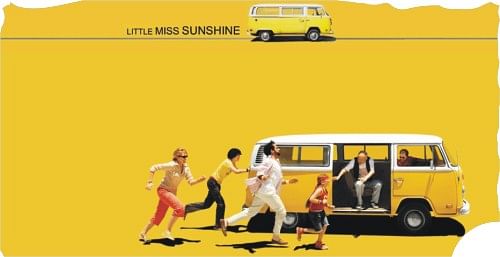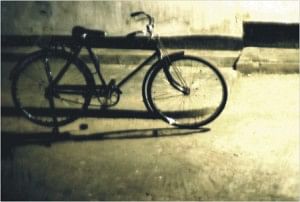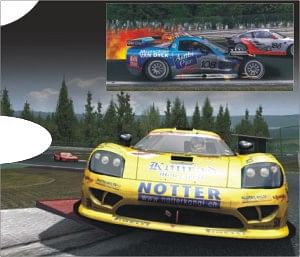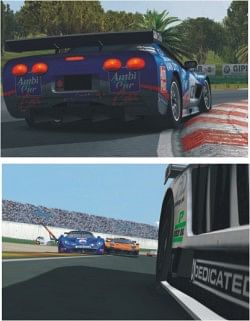Little Miss Sunshine
Cast & Credits
Richard: Greg Kinnear
Frank: Steve Carell
Shery: Toni Collette
Grandpa: Alan Arkin
Olive: Abigail Breslin
Dwayne: Paul Dano

The first thing you see are the blue eyes of a little girl staring right at the screen so intently, it seems she could peer right into the audience souls. Only she's not looking at us. The reflection in her big plastic glasses reveals she's gazing at a beauty pageant on TV, at the moment the winner is being crowned. She's studying this moment, rehearsing it and rehearsing for it. Just a few seconds into "Little Miss Sunshine" we know it's a movie about dreams -- and illusions.
A couple days later, after an eventful 700-mile journey with her family in a vintage VW van from Albuquerque to Redondo Beach, the girl's dream at last appears within reach. They approach the Ramada Inn where the pageant is being held, they can see the building from the freeway -- it looks close enough to touch, but they can't find the exit that will actually get them there. That moment has a lot to say, not only about the illusive, ever-shifting concrete landscape of Southern California, where you always seem to be moving down some predefined course but never quite arriving -- and about the elusive nature of those American Dreams we all chase, the detours we follow -- and the roads we don't.
It is a gentle family satire and a classic American road movie dealing with the nonconformity over the superficiality of conventional American values.
"Little Miss Sunshine" shows us a world in which there's a form, a brochure, a procedure, a job title, a diet, a step-by-step program, a career path, a prize, a retirement community, to quantify, sort, categorize and process every human emotion or desire. Nothing exists that cannot be compartmentalized or turned into a self-improvement mantra about "winners and losers."
The opening montage introduces us to the Hoover family one at a time: Olive (Abigail Breslin) is the aspiring beauty queen. Her dad Richard (Greg Kinnear) is an astonishingly unsuccessful motivational speaker. He's pathologically obsessed with winning because he's never tasted it himself. Olive's mom Sheryl (Toni Collette) values family above all else, and her nerves are fraying over trying to hold this one together.
Grandpa (Alan Arkin), Olive's coach, spends hours working on her dance routine with her. Grandpa has been kicked out of a retirement home, for sleeping around and for snorting heroin. His philosophy is that you'd have to be crazy to do smack when you're young, but when you get old, you'd be crazy not to.
Uncle Frank (Steve Carell), Sheryl's brother, is the Number One Proust scholar in the world, and has just attempted suicide because he fell in love with a graduate student who dumped him for the Number Two Proust scholar in the world. And Olive's teenage brother Dwayne (Paul Dano) hasn't spoken in nine months. He's not depressed, exactly; he's been reading Nietzsche and has taken a vow of silence while training to get into flight school. Plus, he hates everybody.
After our initial introductions, "Little Miss Sunshine" does something quite extraordinary: It gives us a single, nearly 20-minute scene built around a family dinner of takeout fried chicken in which we learn everything about Hoover family dynamics. It's a daring move that establishes the movie's characters and comedic tone, and then ... road trip!
You just won't see a better acted, and better cast, movie than "Little Miss Sunshine." These actors (and their directors, Jonathan Dayton and Valerie Faris) grasp how unspoken reactions can be funnier than dialogue or punchlines, and how pain can be the source of the most satisfying comedy.
All the actors play the emotions straight and true. Dano, his dead black eyes obscured by thick bangs and set into a pale face that seems to be imploding with teen alienation and disgust, just has to tilt his head almost imperceptibly to bring down the house. Kinnear, a fine comic actor, gets the opportunity to let whole scenes play out wordlessly across his face -- having conversations in his head while driving, or trying to figure out an appropriate response to the talent portion of the Little Miss Sunshine contest.
Carell is a miracle in pink-and-blue-striped socks. He creates a character whose pain surrounds him like a hard plastic bubble. And the less he seems to do, the funnier he gets. He makes the name "Nietzsche" (which he pronounces crisply as "Neet-chah") inexplicably hilarious. And how to describe the way Uncle Frank runs? It's an intellectual run --- performed as if the act of running had been studied, broken down into its component parts, and then reassembled -- all analysis, no grace.
It's almost inhumanly human, and pricelessly funny.

The internet has already lived up to its hype - and it'll soon exceed it. Wildly. This is one hell of a ride to miss. And I don't want you guys to miss it.
I haven't been writing my column Sites Unseen for a couple of months. It was mainly because I was too concerned whether it was good enough; whether you guys liked it enough. Too much concern can ruin stuff, and many of you who liked the column missed it.
But recently so much has changed! The new internet will change everything (love, war, commerce, what it means to be a human…). This turmoil is too good not to experience at its best.
So here I am, back again with my Sites Unseen. The new internet is changing everything. And I'm here to help you be a part of it. Hang on!
 For today, I'll just give you some neat blogs and articles to read. Few of those “hard to find gems.” Read on!
For today, I'll just give you some neat blogs and articles to read. Few of those “hard to find gems.” Read on!
“You've got to find what you love”
By Steve Jobs
http://news-service.stanford.edu/news /2005/june15/jobs-061505.html
Steve Jobs, CEO of Apple Computer and of Pixar Animation Studios, tells three stories from his life a speech at the Stanford University. Read. It's good stuff. It's beautiful.
“Remembering that I'll be dead soon is the most important tool I've ever encountered to help me make the big choices in life. Because almost everything all external expectations, all pride, all fear of embarrassment or failure - these things just fall away in the face of death, leaving only what is truly important. Remembering that you are going to die is the best way I know to avoid the trap of thinking you have something to lose. You are already naked. There is no reason not to follow your heart.”
“Your time is limited, so don't waste it living someone else's life. Don't be trapped by dogma which is living with the results of other people's thinking. Don't let the noise of others' opinions drown out your own inner voice. And most important, have the courage to follow your heart and intuition. They somehow already know what you truly want to become. Everything else is secondary.”
Ian Ybarra's Blog
www.ianybarra.com
This, by far, is one of my most favourite blogs out there. Simply because it tells you to “find and do work you love.” And it gives you every reason to do so! Ian Ybarra is a genius about all this, and I've read his entire blog: it's that good. Especially if you're in need of some serious soul searching for doing what you should really be doing in your life. READ!
How to be creative
By Hugh Macloid
http://www.gapingvoid.com/Moveable_Type/archives/000932.html
It's actually more "how to deal with being creative". If you are one of those “creative types,” you'll find it a beautiful, amazing, and very popular article written by the trendy blogger Hugh Macloid. It has some really good advice if you can take it.
The good thing about this is not necessarily that it tells you how to be creative. The good thing is that it dispels a lot of myths that people may have that keep them down (e.g. I'm not born creative, etc). This is more inspirational than a definite how-to guide. His blog is gapingvoid.com, DO check his stuff out. You don't want to miss this.
Hindsights
By Guy Kawasaki
http://blog.guykawasaki.com/2006/01/hindsights.html
You ever have those times when all you can think is, “I should have done this when I could.” Or maybe you have thought, “What would happen if I had done something differently?”
This is some very useful and insightful advice by blogger and author Guy Kawasaki. It would have been the best thing you've read in quite a while, but you should have just read some very nice stuff already mentioned earlier!
“I am going to talk about hindsights today. Hindsights that I've accumulated in the past thirty-two years of my life. Don't blindly believe me. Don't take what I say as “truth.” Just listen. Perhaps my experience can help you out a tiny bit.”
Read through it. He promises to be “short, sweet, and not boring.” (And he keeps the promise.) And when you're done, check out the rest of it at: http://blog.guykawasaki.com/2006/01/hindsights_ii_t.html. Don't forget to check back the blog either. blog.guykawasaki.com
Anyways, after giving you these links with stuff to read, I'll move on to some self-advertising. I've started a photoblog on nice photographs of Bangladesh that I took, photos that'll present the country on a beautiful positive way. Check it out at www.bangladesh.shutterchance.com. BDcomics.net, my blog on downloadable comics has grown in these months. It has now got even more visitors, more content and more people working on it. Check it out if you're into comics. And there's always my nice collection of photography at flickr.com at photos.niloy.net.
All right! This is the first Sites Unseen after quite a long while. Make sure you mail back at [email protected] and tell me if you liked it.
GTR2
 Minimum System Requirements
Minimum System Requirements
System: 1.8 GHz Intel Pentium IV or equivalent
RAM: 1024 MB
Video Memory: 64 MB
Hard Drive Space: 1700 MB
Recommended System Requirements
System: 3 GHz Intel Pentium IV or equivalent
RAM: 1024 MB
Video Memory: 256 MB
Hard Drive Space: 1700 MB
GTR 2 is the sequel to 2005's GTR FIA Racing, a hearkening back to the good old days of sim racing. It's an expansive and challenging sequel to one of the best racing games of last year.
Content
The game revolves around GT racing with a compelling mixture of multiclass sports cars from makers such as Ferrari, Porsche, TVR, Saleen, and many more, all competing on a cosmopolitan lineup of real-life tracks from all over the world. Additionally, the driving model, which so authentically captured the thrilling yet often twitchy experience of driving a highly tuned sports car in the original GTR, is even more finely tuned in the sequel.
The game
The first and most obvious way the GTR developers have done this is through the driving school, an expansive tutorial that has seemingly been designed to take you from the ground up--from your first moments in the car to competing tightly with the game's demanding artificially intelligent drivers (or with up to 27 other players via the game's excellent online multiplayer racing). Categories covered in driving school include the basics, such as acceleration and braking, up through cornering and overtaking, and finally, into section-by-section breakdowns of many of the tracks featured in the game. Each category includes a text breakdown that covers the theory behind each racing concept, as well as the specific goal you need to accomplish in order to pass that particular challenge. You can also practice the challenge before an "official" attempt against the ghost car or watch the ghost car's lap to view proper braking or turn-in points, which is essential for some of the trickier challenges.
Done with the tutorials
You'll find a number of game modes and options in GTR 2 just waiting to beat you down and bring you back to earth. With multiple car classes available, you'll easily find a ride to suit your speed. GTR 2's three main racing modes are race weekend, championships, and 24-hour race. A race weekend is a single event, complete with multiple practice and qualifying rounds, as well as the actual race itself. Championship mode includes both the 2003 and 2004 official FIA GT seasons, as well as the custom championships you open up by completing challenges in the driving school. New for GTR 2 are the 24-hour races on tracks such as Spa-Franchorchamps, Monza, and China's Zuhai circuit. You can scale down these grueling endurance races to a more manageable size (say one or three hours) and still experience the same gradual day-to-night transition you would in a 24-hour race.
There are also three difficulty levels to choose from--novice, semi-pro, and simulation.
 The experience
The experience
And it's there--on the asphalt--that you feel the full brunt of the GTR 2 experience. As in the last game, with all aids disengaged, this is one of the more thrilling and challenging racing experiences you can have. The cockpit view, which features impressively detailed and authentic interiors for every car in the game, puts you in the driver's seat, and lap after Ap, you are jostled and thrown around tracks at ludicrous speeds. Every shake and wobble of your car is felt and demands your full attention. Whether playing the game with a joystick or with a wheel and pedal combination (or, heaven forbid, with a keyboard), you find yourself consistently balanced on a knife's edge, trying to pull out the last remaining ounce of speed from your car while fighting against your rapidly degrading tires. A hair too much tire on the curb or just slightly too steep an angle into a corner can spell disaster, such as a spin into the grass or, worse, a full-on collision with the wall--where you'll experience the game's sophisticated damage modeling.
Customising options
Part and parcel with a driving sim game comes a wealth of tuning options for your ride, and GTR 2 absolutely does not skimp here. Everything from fuel strategy to tire pressure, and from springs and camber to toe-in and the anti-roll bar, is adjustable in the game. If you're an experienced virtual gearhead, the wealth of options here will certainly be a boon. For the novice, it will likely seem overwhelming. Thank goodness, then, that the game's online options will let you download user-created sample setups that are organized by track.
The visuals
The cars and tracks found in the game are expertly modeled, and on a mid- to high-end computer, you'll enjoy seeing the wealth of detail on display on the tracks. They also provide enough small details, such as flag-waving race officials and a long train of spectators that line the long straight at Spa, to keep you engaged. The trade-off for all of this quality is that, just as with the last GTR, you'll need a hefty setup to get the game running at a respectable clip. Even with the 3.20GHz/2GB RAM machine it encountered enough frame-rate issues at the default setting to raise concern--it's difficult to imagine the game being very playable at the minimum system requirements of 1.8GHz/512MB RAM.
The noise
While you don't necessarily expect a wealth of variety in a racing game's sound presentation, GTR 2 has some audio treats for the attentive listener. First, the sound of the car engines is wonderful, from the gentle, slurring purr of a G3-class Porsche, to the furious, and frankly a bit scary, wail of a TVR T400R. But the fun doesn't stop there. When tearing down the long straight at high speeds, you'll hear the sounds of dust and debris minutely clanking against the bottom of the car; in the turns, you'll notice the protesting squeal of tires as they strain against your steering input; and if you run wide in a turn, your teeth will chatter as your car loudly bumps over the curbing.
The ability to skip directly past the first GTR game and start with GTR 2 is a testament to this game's quality and its slightly gentler learning curve. Once on the track, though, GTR 2 unapologetically demands your full attention as a participant, which is exactly what a highly tuned and deep racing sim should do. Provided you've got the PC horsepower to run it, this game's level of quality and discount price point practically scream for your attention.
